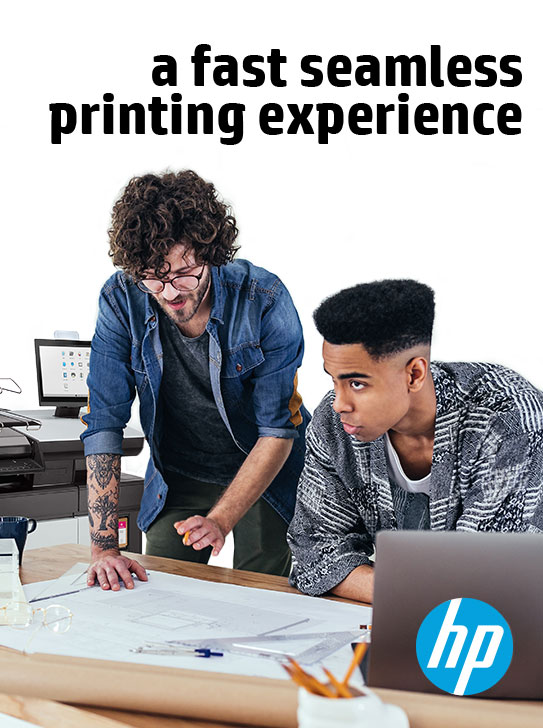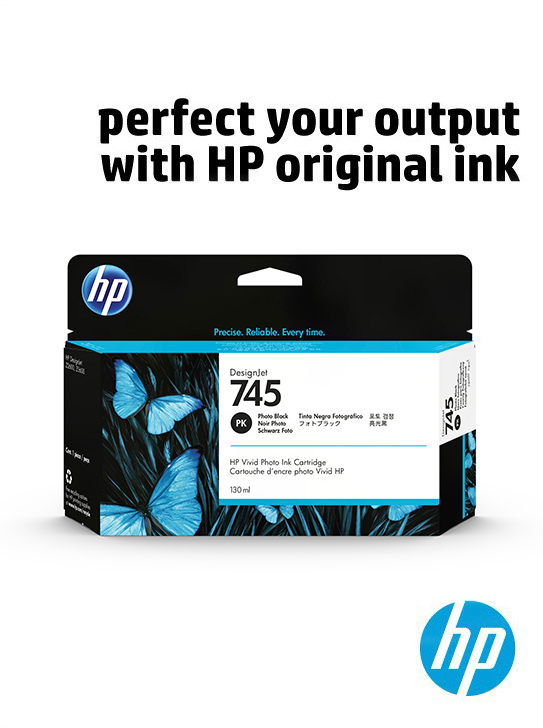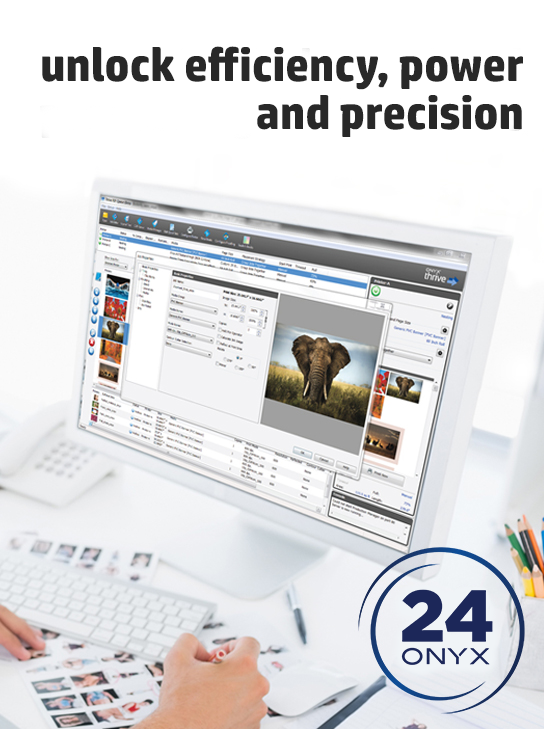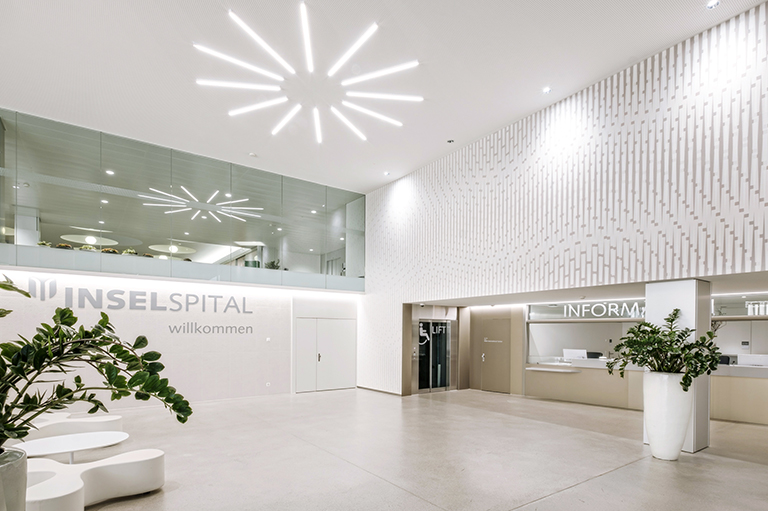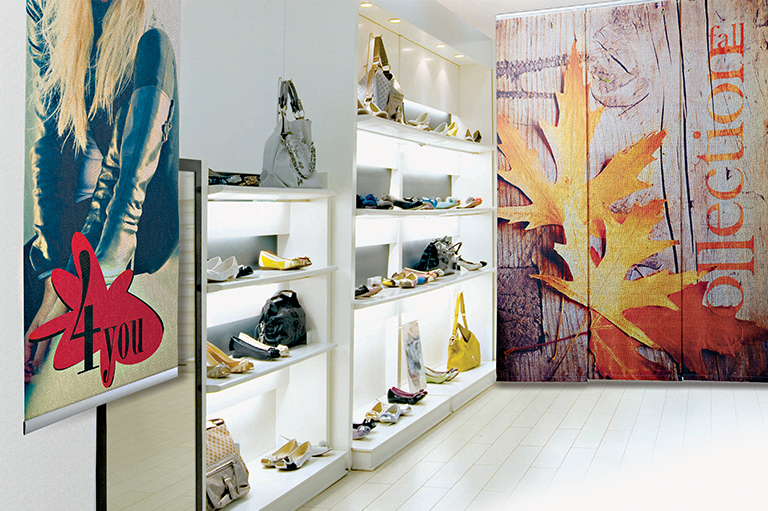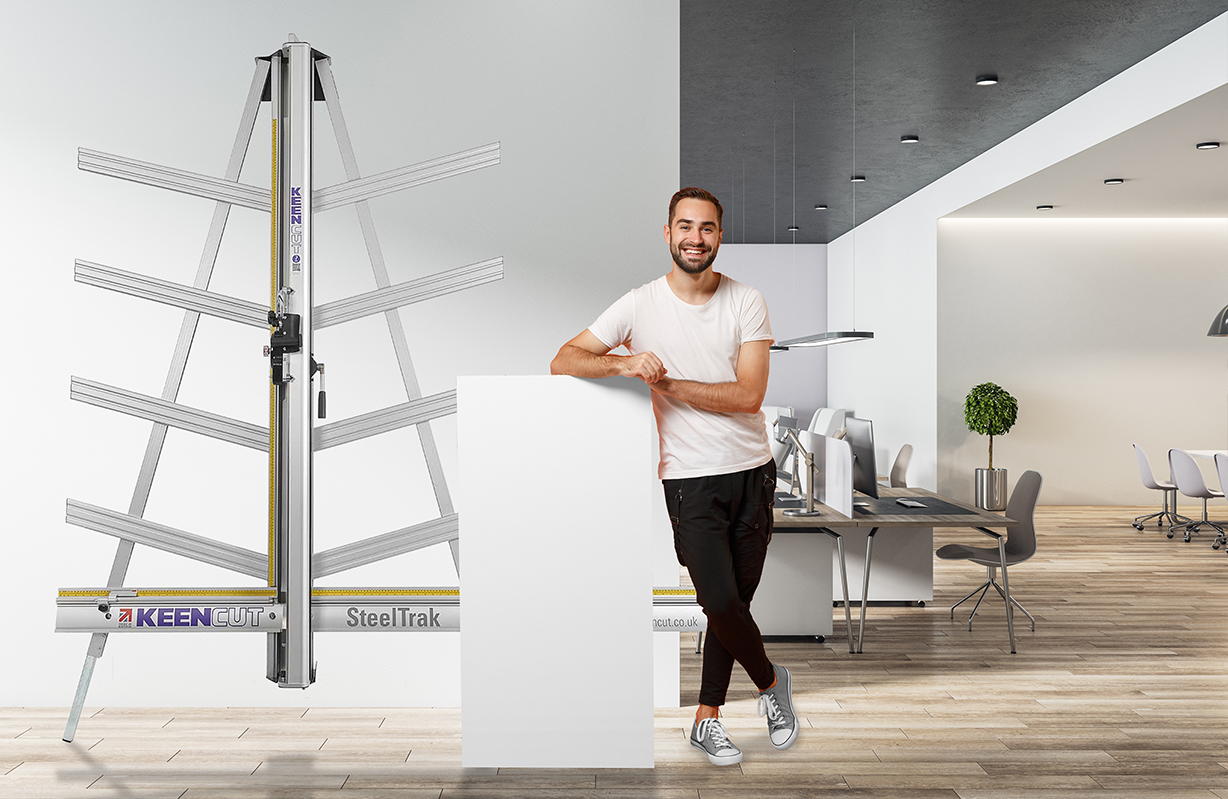-
Read more ...
HP Inc. today announced the new HP DesignJet T830 24 inch multifunction printer, an ultra-compact, versatile large format printing solution for architects, engineers and construction teams to seamlessly collaborate onsite and across sites by printing, copying, scanning and sharing plans with a single device.
The 24 inch T830 joins the HP DesignJet T830 multifunction printer series creating a portfolio that can handle any size project, yet offering the same HP Designjet quality and reliability in what is now the most compact MFP device available on the market today.1
“HP multifunction printers open new ways to help professional teams communicate and collaborate using a single device. Our customers are increasingly demanding solutions that enable them to share easily including agile transitions from digital to hard copy and back,” said Guayente Sanmartin, General Manager and Global Head, HP Large Format Design Printing, HP Inc. “It’s amazing to bring the most advanced HP printing technologies to support the teamwork of architects and engineers designing and building the future.”
In its first product demonstration, the 24 inch T830 printer will debut at Autodesk University, Las Vegas, November 14-16, in the HP booth (#A517).
In another HP DesignJet product development, HP announced the expansion of HP Click to all HP DesignJet T-Series printers. With no need for a driver, the software offers easy, simple one-click printing, plus drag and drop multi-page PDF printing and real-print preview, while optimising media usage and costs. New HP DesignJet T120 and HP DesignJet T520 printers now also offer faster printing speeds.2
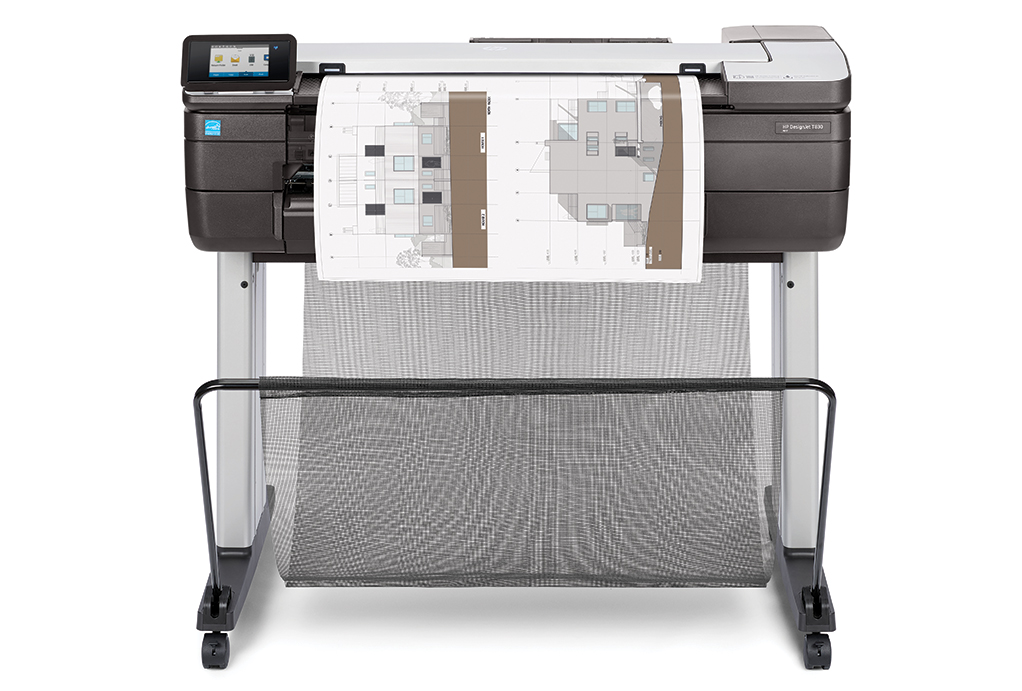
Evolve team collaboration with HP DesignJet multifunction printers
Ideal for architecture studios and construction offices preferring a smaller footprint, the HP DesignJet T830 24 inch multifunction printer offers a convenient solution with a range of communications options than can help increase collaboration. Print, scan, copy and share drawings, project schedules, renders, presentations and more.
Benefits and features of the new printer include:
• Immediately share - project meeting results to peers and partners. Print A1/D sized printed in up to 26 seconds
• Wireless printing - from smartphone, tablet or computer with Wi-Fi Direct and HP Mobile Printing.3
• Use scanner - to make copies of originals for use in the field while preserving the master.
• Copy - sketches and hand-annotated drawings for immediate team distribution.
• HP smart app - to share scanned images with email contacts, post to cloud
• HP click printing - software for easy printing of project sets and PDF documents
• Flexibility to print half-sized documents - with A4/A3 input tray
1. The HP DesignJet T830 24 inch and 36 inch multifunction printers are the most compact large-format devices performing print/scan/copy functions based on H x W x L specifications published as of October, 2017
2. The 2018 edition HP DesignJet T120 prints one page in 45 sec. Both models print multiple-page A4 or letter-sized jobs from the A4/A3 input tray at a rate of 6 pages per minute.
3. Local printing requires mobile device and printer to be on the same network (usually Wi-Fi access points bridge wireless to wired connections) or have a direct wireless connection. Wireless performance is dependent on physical environment and distance from access point. Wireless operations are compatible with 2.4 GHz operations only. Remote printing requires an Internet connection to an HP web-connected printer. Wireless broadband use requires separately purchased service contract for mobile devices. Check with service provider for coverage and availability in your area. See http:www.hp.com/go/designjetmobility for more details.
Forward-Looking Statements
This news release contains forward-looking statements that involve risks, uncertainties and assumptions. If the risks or uncertainties ever materialize or the assumptions prove incorrect, the results of HP Inc. and its consolidated subsidiaries (“HP”) may differ materially from those expressed or implied by such forward-looking statements and assumptions.
All statements other than statements of historical fact are statements that could be deemed forward-looking statements, including but not limited to any projections of net revenue, margins, expenses, effective tax rates, net earnings, net earnings per share, cash flows, benefit plan funding, deferred tax assets, share repurchases, currency exchange rates or other financial items; any projections of the amount, timing or impact of cost savings or restructuring and other charges; any statements of the plans, strategies and objectives of management for future operations, including the execution of restructuring plans and any resulting cost savings, revenue or profitability improvements; any statements concerning the expected development, performance, market share or competitive performance relating to products or services; any statements regarding current or future macroeconomic trends or events and the impact of those trends and events on HP and its financial performance; any statements regarding pending investigations, claims or disputes; any statements of expectation or belief; and any statements of assumptions underlying any of the foregoing.
Risk, uncertainties and assumptions include the need to address the many challenges facing HP’s businesses; the competitive pressures faced by HP’s businesses; risks associated with executing HP’s strategy; the impact of macroeconomic and geopolitical trends and events; the need to manage third-party suppliers and the distribution of HP’s products and the delivery of HP’s services effectively; the protection of HP’s intellectual property assets, including intellectual property licensed from third parties; risks associated with HP’s international operations; the development and transition of new products and services and the enhancement of existing products and services to meet customer needs and respond to emerging technological trends; the execution and performance of contracts by HP and its suppliers, customers, clients and partners; the hiring and retention of key employees; integration and other risks associated with business combination and investment transactions; the results of the restructuring plans, including estimates and assumptions related to the cost (including any possible disruption of HP’s business) and the anticipated benefits of the restructuring plans; the resolution of pending investigations, claims and disputes; and other risks that are described in HP’s Annual Report on Form 10-K for the fiscal year ended October 31, 2015, HP’s Quarterly Reports on Form 10-Q for the fiscal quarters ended January 31, 2016, April 30, 2016 and July 31, 2016, and HP’s other filings with the Securities and Exchange Commission. HP assumes no obligation and does not intend to update these forward-looking statements. HP’s Investor Relations website at http://www.hp.com/investor/home contains a significant amount of information about HP, including financial and other information for investors. HP encourages investors to visit its website from time to time, as information is updated and new information is posted.
-
Read more ...
By 2025 the renovation and expansion of the Inselspital (main hospital) in Bern will be completed. An important building block in the project was to redesign the main entrance. With SIHL EASY2WALL the complete solution for innovative wall designs, Sihl Direct have made a significant contribution to the friendly atmosphere created for the entrance. The new anti-bacterial coated glass textile – Glass Textile design2wall HealthClean 295 matt 2525 was used. The product is optimal for application areas with the highest demands on durability and cleaning, exceeding the product requirements of the project.
The hospital invested in a new entrance hall – with over 5000 people entering and exiting daily, this is the most heavily used part of the entire building complex. The aim of the new design was to make the orientation easy and comfortable movement for the visitors. An escalator and a lift lead visitors from the ground level entrance into the first floor of the main building. Floors, walls and ceilings convey an atmosphere that does not scream out „hospital”. The wall design above the reception area is a special highlight. The focus was to achieve an atmosphere that gives both patients and visitors alike a positive first impression. The pattern is simple and light, almost weightless with its fine grey tones. The design was created by designer Susanne Dubs in collaboration with the architect agency Bauzeit Architekten, who are responsible for the entire Hospital project.
The one stop solution for flexible wall design
For the technical application, everything from planning through printing to the actual application on the wall, the project team left in the expert hands of SIHL EASY2WALL. The One-Stop-Shop-solution allows designers full creative freedom, gives the architects comprehensive support during planning and implementation, as well as winning the opinions of the building constructors/owners with a wall design that is visually, haptically and technically perfect.
High quality wallpaper for the clinical section
“Already before the creation of the design the specialists from SIHL EASY2WALL, ensured the realisation” says project manager Anette Wabner, delighted with the competent support. They constantly monitored and optimised the precise transmission, contour detail and colour tones. Using the environmentally-friendly sublimation printing process the pattern was then sublimated to the wallpaper resulting in a true reproduction of colours.
Especially developed for use in the clinical sector, the fibreglass textile really is so high that it provides a reinforcement of the surface – cracks in the walls are not just covered but they can be reinforced to prevent further cracking. Thanks to the high tear resistance, no additional treatment is needed to remove the wallpaper drops from the walls in one piece, provided that the wallpaper was applied in accordance with the Sihl recommendations.
Dye sublimation inks for indestructible prints
Not only can Glass Textile design2wall HealthClean 295 matt 2525 be cleaned using conventional cleaning detergents, it is also resistant against most alcoholic and disinfecting agents too. Cleaning using ethanol is even possible, without dissolving the inks or destroying the printed image. Dye sublimation achieves the best possible fixation of inks. Together with a coating developed to receive these inks, whereby focus was laid heavily on the resistant to various influences, is a virtually indestructible print achieved. Neither scratching nor impact with hard objects can destroy the printed image. Even tests with sandpaper leave a barely visible effect on the surface.
About SiHL
Not only can Glass Textile design2wall HealthClean 295 matt 2525 be cleaned using conventional cleaning detergents, it is also resistant against most alcoholic and disinfecting agents too. Cleaning using ethanol is even possible, without dissolving the inks or destroying the printed image. Dye sublimation achieves the best possible fixation of inks. Together with a coating developed to receive these inks, whereby focus was laid heavily on the resistant to various influences, is a virtually indestructible print achieved. Neither scratching nor impact with hard objects can destroy the printed image. Even tests with sandpaper leave a barely visible effect on the surface.
-
Read more ...
HP Inc. announced a new range of durable textiles certified for HP Latex printers to produce soft signage and decor applications, combining durability and outstanding print quality with the benefits of water-based HP Latex technology.
The new textiles from selected media vendors expand possibilities for durable HP Latex printing for soft signage applications, including backlit and frontlit banners, blockouts and backdrops and point of purchase displays, with higher durability. These textiles also enable new home decor applications such as curtains and blinds, cushions, lampshades and bags on materials made from 100% cotton, cotton linen or polyester. Some of the new textiles also achieve washability with a heating process after printing.
“We continue to expand on HP’s promise to deliver new possibilities for HP Latex printers. New durable textiles for soft signage and décor open new growth opportunities with HP Latex water-based technology,” said Joan Pérez Pericot, General Manager, HP Large Format Graphics Business, HP Inc. “Unlike solvent-based printers, HP Latex technology can print on traditional signage substrates such as banners and vinyls, in addition to textiles, including uncoated substrates.”
New textile applications for the HP Latex
At SGIA in booths 1029 and 1045, HP is presenting a textile showcase and printing on HP Latex printers, including the HP Latex 3600 Printer, winner of the 2017 SGIA Product of the Year Award in the Roll-to-Roll Solvent/Latex (over 80 inches) category. The HP Latex 3600 Printer supports high-volume printing and high monthly duty cycles, designed for PSPs needing long-run, uninterrupted printing.
Textile printing is also supported on the HP Latex 1500 Printer, a robust, affordable printing solution, delivering fast turnarounds, HP Latex 560 and 570 Printers, designed for medium-to-large PSPs with increasing print volumes, and for smaller volumes, on the HP Latex 365 Printer.
HP PrintOS for sign and display production
At SGIA in booths 1029 and 1045, HP is presenting a textile showcase and printing on HP Latex printers, including the HP Latex 3600 Printer, winner of the 2017 SGIA Product of the Year Award in the Roll-to-Roll Solvent/Latex (over 80 inches) category. The HP Latex 3600 Printer supports high-volume printing and high monthly duty cycles, designed for PSPs needing long-run, uninterrupted printing.
- Applications Centre - offering easy access to HP Signage Suite for easy web-based design and ordering jobs for signage and decor, and HP WallArtSuite for decorative applications. HP WallArt Suite is updated to include cushions as a new application, in addition to wallcoverings, canvas, decoration, posters and cushions
- HP Media Solutions Locator - a fast and assured way to find certified media availability by region.
- HP Print Beat - providing visibility into press/printer performance for continuous improvement of print production operations.
- HP Latex Mobile App - enabling unattended printing by getting printer alerts when you are not in front of the printer or even when you are out of the shop
- HP PrintOS Box - a file exchange which simplifies print file receipt, content validation and routing to production
1. Information on certified media is available for customers in the HP Media Locator, in HP PrintOS.
Forward-Looking Statements
This news release contains forward-looking statements that involve risks, uncertainties and assumptions. If the risks or uncertainties ever materialize or the assumptions prove incorrect, the results of HP Inc. and its consolidated subsidiaries (“HP”) may differ materially from those expressed or implied by such forward-looking statements and assumptions.
All statements other than statements of historical fact are statements that could be deemed forward-looking statements, including but not limited to any projections of net revenue, margins, expenses, effective tax rates, net earnings, net earnings per share, cash flows, benefit plan funding, deferred tax assets, share repurchases, currency exchange rates or other financial items; any projections of the amount, timing or impact of cost savings or restructuring and other charges; any statements of the plans, strategies and objectives of management for future operations, including the execution of restructuring plans and any resulting cost savings, revenue or profitability improvements; any statements concerning the expected development, performance, market share or competitive performance relating to products or services; any statements regarding current or future macroeconomic trends or events and the impact of those trends and events on HP and its financial performance; any statements regarding pending investigations, claims or disputes; any statements of expectation or belief; and any statements of assumptions underlying any of the foregoing.
Risk, uncertainties and assumptions include the need to address the many challenges facing HP’s businesses; the competitive pressures faced by HP’s businesses; risks associated with executing HP’s strategy; the impact of macroeconomic and geopolitical trends and events; the need to manage third-party suppliers and the distribution of HP’s products and the delivery of HP’s services effectively; the protection of HP’s intellectual property assets, including intellectual property licensed from third parties; risks associated with HP’s international operations; the development and transition of new products and services and the enhancement of existing products and services to meet customer needs and respond to emerging technological trends; the execution and performance of contracts by HP and its suppliers, customers, clients and partners; the hiring and retention of key employees; integration and other risks associated with business combination and investment transactions; the results of the restructuring plans, including estimates and assumptions related to the cost (including any possible disruption of HP’s business) and the anticipated benefits of the restructuring plans; the resolution of pending investigations, claims and disputes; and other risks that are described in HP’s Annual Report on Form 10-K for the fiscal year ended October 31, 2015, HP’s Quarterly Reports on Form 10-Q for the fiscal quarters ended January 31, 2016, April 30, 2016 and July 31, 2016, and HP’s other filings with the Securities and Exchange Commission. HP assumes no obligation and does not intend to update these forward-looking statements. HP’s Investor Relations website at http://www.hp.com/investor/home contains a significant amount of information about HP, including financial and other information for investors. HP encourages investors to visit its website from time to time, as information is updated and new information is posted.
-
Read more ...
Why is it that, as the market leader in large format print cutters, Keencut does not offer a laser for cutline indication on its vertical machines, but it does use lasers to calibrate Precision Bench Top Cutters?
The answer is quite simple, we design our products so that every feature gives maximum performance and our tests have proven that a simple clear plastic Sightline Strip outperforms a high cost laser every time.
How does the Sightline Strip work?
The Sightline Strip is a clear plastic strip which starts off life wider than it needs to be when it is attached with adhesive to the edge of the clamping bar close to the cut line. The strip is then cut down the length by the blade on the SteelTraK. The result is a precision indicator of exactly where the blade is going to cut. The key thing to understand is that as the edge of the sightline strip is the indicator it has no thickness and therefore pinpoint accurate.
Keencut was the first company to have a cutline indicator on a vertical substrate cutter of this type.
So, why not use a laser? A laser beam is perfectly straight even when fired from here to the moon, surely over a few metres it is going to be super accurate and they are as cheap as a sightline strip.
Yes, they are extremely accurate, that is why we use one to measure the straightness on every single Precision Bench Top Cutter we produce. It is also true that some lasers are very cheap, but it is the computerised measuring equipment we use to control and measure the beams position to within hundredths of a millimetre that costs many thousands of pounds.
Some time ago we carried out a study with the help of a specialist laser company. The only criteria we set was that any solution would not cost the end user any more than £1,000 (on top of the price of the SteelTraK). There were two ways of approaching this: -
The ideal solution is to have a laser line that is bright, well defined and ideally about the thickness of a crop line (we worked on 0.2mm). The ideal position for a laser is suspended above head height a few metres behind the operator so that it can focus a line of red light down the length of the machine. A special lens changes the laser beam into a fan shape and it is the edge of the fan that creates the line. This type of arrangement creates a line that is typically around 1-2mm wide, not fine enough for our purposes and the edge of the line was not sharp enough either, especially when compared to the crisp cut edge of the Sightline Strip.
The width of a crop line is dependant up many things but for our purposes let’s say its 0.2mm. The laser is set back, say, 2m from the SteelTrak, the end of the laser unit only has to move by 0.005mm for it to move the laser line by the thickness of the crop line. How on earth could you calibrate something that fine and ensure it remains accurate despite vibration, expansion/contraction or just general flexing and movement between the SteelTrak and the laser fixing?
So, what if the laser were fixed closer to the machine, for example at the top end of the SteelTrak and the ‘fan’ set to produce a line down the material? The beam would still be 1-2mm wide but there would also be focussing issues as the laser line would be much closer to the lens at the top of the machine than it would at the bottom.
Option two, fasten the laser to the cutting head and align the beam with the cutting line and by moving the cutting head up and down the laser it should accurately give cutline indication along the whole length of the cutter, problem solved…….. or is it?
This is all very well if you just need to align the laser to one crop line and can guarantee your printing is square to the edge of the board and be sure the board itself is perfectly square but what if it is not, just think how this would be done:
So, firstly raise the head to the top of the board and align the crop line with the laser then clamp the board in place, move the cutting head and laser to the bottom to find it is not in line with the bottom crop mark. The problem then is, how can you manoeuvre the bottom end of the board to align to the crop mark and be sure you do not disturb the setting at the top. Quite simply, you cannot be sure, the laser can only be at one crop line or the other.
The Sightline Strip along with the SteelTraK’s unique pressure sensitive clamp makes light work of this situation.
Lightly clamp the board so that it holds the board in place but allows you to rotate and slide the board. Align both crop marks with the edge of the Sightline Strip. Once happy that the alignment is correct, increase the pressure on the clamp and take the cut with full confidence.
Sometimes simplicity does win over expensive technology!
About Keencut
Keencut designs and manufactures manual cutters for the print finishing and picture framing markets, with world-leading accuracy and reliability. Products are sold around the globe to most countries in Europe, the USA, and as far afield as Russia and Australia.
We design and manufacture our entire product range at the Keencut factory in Corby, UK. We use the finest materials and state of the art manufacturing techniques to ensure the highest quality and reliability, and our products come with a minimum five-year comprehensive guarantee plus a minimum 20-year guarantee on all rotating and sliding bearings.
With a broad range of manual cutters, Keencut meets the ever-increasing requirements of customers in the sign-making, large & small format printing, and picture framing industries. Our dedication to finding the ultimate precision engineering solution to each application means that our products have a worldwide reputation as the most accurate, reliable and easy to use.
If you are looking for precision and durability in your cutter, choose Keencut.
Skip to Content
- Create an Account
- Offers for you

+44 (0) 1527 853 136



